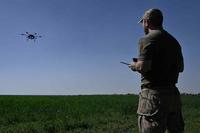The British government was spooked back in 1935. Not because of Hitlers air force or his infantry. Because of his death ray.
Newspapers screamed that the Nazis might have a super-weapon that could incinerate living tissue or detonate a bomb at long distance. Flooded by letters begging for a response, the British Air Ministry asked prominent physicist Robert Watson-Watt to see if a radio-wave-based death ray was feasible. Within ten days Watson-Watt reported that such a weapon was unlikely. But using radio waves to locate an approaching bomber was a real possibility. And that's how radar was born.
Within ten days Watson-Watt reported that such a weapon was unlikely. But using radio waves to locate an approaching bomber was a real possibility. And that's how radar was born.
Now, seventy years later, the invention may be coming full circle, Aviation Week reports. The Pentagon is actively developing active electronically scanned array (AESA) radars that might be "used as weapons. They are fulfilling the U.S. Air Force's desire for offensive tools that can find enemy threats, accurately identify them and immediately strike."
Some of the airborne AESA radars... use thousands of small transmitters/receivers, each a couple of inches square, that allow the array to conduct many tasks simultaneously. Those include detection of small, even stealthy targets, tracking and communications... and "jamming"... Possible AESA techniques for attacking another radar could include burning through the target radar's antenna side-lobes, filter side-lobes, or other known features of the target system. Radar specialists suggest it is reasonable to suppose this capability is already available to some fielded systems...
[Airborne radar weapon development] appear[s] to be focused on cruise missiles and self-defense against anti-radiation, home-on-jam and air-to-air missiles. The radars seem particularly effective against the latter categories because energy available to focus on the approaching missile increases as an inverse square as distance decreases.
Radar's close cousins, High Power Microwaves (HPMs), are also being groomed as energy weapons. They tend to generate ultra-strong bursts across a range of frequencies, for just a few trillionths of a second. AESA would zap targets with longer, more directed blasts.
While HPM produces higher peak power, AESA often generates greater average power. That produces different operational and targeting strategies. For example, Raytheon's [HPM-based] airport protection system uses infrared sensors to find the target and determine where to focus its beam. It also produces effects at longer range, possibly as much as 100 mi., because it produces powerful pulses of energy. AESA radar has the built-in ability to find and track a target, so it can be held on the target for the necessary additional microseconds needed to create its weapons effect.
Some HPM pulses are designed to be very broadband, covering "many gigahertz" of frequencies, so they are more likely to find any opening or vulnerability in a target, the radar specialist says. AESA radar has a narrower frequency range, but it uses its radar capability to identify a target, search a library for its vulnerable frequencies and then tailor the signal for the specific target.
THERE'S MORE: Just in case this story couldn't get more sci-fi, some in the Defense Department think that unmanned planes are the best place to put these ray guns.
"High-power microwave [HPM weapons] on an aircraft is an engineering challenge, particularly when you have a person in it," says a senior Pentagon official. "It's a lot easier to shield electronics [needed to control the aircraft] than it is to shield a body. Also, the closer I can get to the target, the more precise I can be [with an energy beam], the less power I need and the wider range of effects I can achieve."
But take this all with a healthy spoonful of salt. So-called "directed energy" weapons have been just around the corner for decades.








